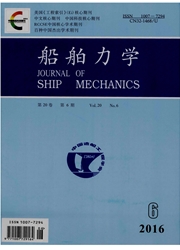

 中文摘要:
中文摘要:
The flow past a finite circular cylinder with a height-to-diameter ratio of 1.5 and an infinite circular cylinder of the same diameter at a Reynolds number Re= 3 900 is investigated using the large eddy simulation(LES). The objective of the present study is to explore the differences of the flow mechanisms between the finite and infinite circular cylinders. It is shown that the free end of the finite circular cylinders affects the wake region significantly. The mean drag coefficient and the fluctuating lift coefficient of the finite circular cylinder are smaller than those of the infinite circular cylinder. The three-dimensional separation and the separated shear layer instability of the finite circular cylinder can obviously be observed. The existence of an arch vortex in the average flow downstream of the free end is demonstrated.
 英文摘要:
英文摘要:
The flow past a finite circular cylinder with a height-to-diameter ratio of 1.5 and an infinite circular cylinder of the same diameter at a Reynolds number Re= 3 900 is investigated using the large eddy simulation(LES). The objective of the present study is to explore the differences of the flow mechanisms between the finite and infinite circular cylinders. It is shown that the free end of the finite circular cylinders affects the wake region significantly. The mean drag coefficient and the fluctuating lift coefficient of the finite circular cylinder are smaller than those of the infinite circular cylinder. The three-dimensional separation and the separated shear layer instability of the finite circular cylinder can obviously be observed. The existence of an arch vortex in the average flow downstream of the free end is demonstrated.
 同期刊论文项目
同期刊论文项目
 同项目期刊论文
同项目期刊论文
 期刊信息
期刊信息
